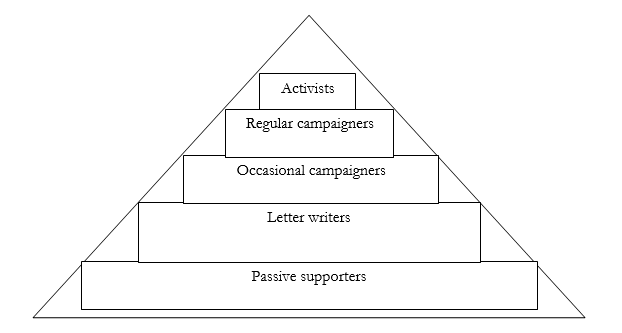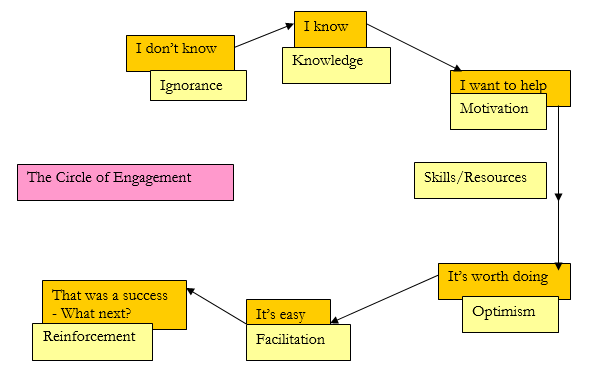Supporters and Activists

Carrying Supporters Along the Path to Social Change
From Awareness to Engagement
Involvement of Grassroots Groups
Carrying Supporters along the Path to Social Change
Supporters are important stakeholders of your organization, who should be consulted and kept informed about your organization’s work. They are also a key power base in terms of political credibility.
Proactively educating supporters about your advocacy asks can really pay dividends – not only in terms of personal change, but also in terms of aligning these important stakeholders to your organization’s advocacy aims. Whilst some will remain passive supporters, many can be nurtured and developed into allies and active supporters of your cause.
The aim is to educate and motivate your supporters, and to develop these until they participate (and give!) to their maximum potential. This is shown in diagrammatic form below:

The objective is to move your supporters as far up the pyramid as possible. This process often starts when they respond to calls for written representations. Then, if their efforts are fruitful, they begin to watch the campaign and can become enlisted as ‘agents’ who watch for associated events and media (and even use these to obtain media coverage for the issue). Then, as they become more involved in the campaign, they may be willing to take an active part in advocacy activities, where their involvement rises over time. Finally, they can become fully committed activists for the cause.
The below are useful principles to assist with this process:
- Encourage participation
- Facilitate participation
- Communicate and celebrate successes
- Communicate appreciation
- Build skills and involvement
From Awareness to Engagement
Awareness is not enough. Many people are already aware, but simply do not think the issue important enough to actively do something about it. To make a difference to people’s lives, you have to take people beyond ‘awareness’, to create a sense of urgency and need for change, and to help them to visualize a new future and empower them to play a part in the movement for change. In short, you need to engage them.
The seven-stage model for engagement is:
- Ignorance
- Knowledge
- Motivation
- Skills/Resources
- Optimism
- Facilitation
- Reinforcement

Understanding this model is essential to the development of an effective advocacy campaign.
Involvement of Grassroots Groups
You may decide to involve grassroots groups in your advocacy work. This can help to spread the advocacy campaign, and to develop their capacity in the process. There are various approaches to their involvement, and the following tool may help you to decide on the most appropriate.
Forming a Coalition

Do not duplicate the work of another coalition. If there is already an appropriate coalition, then you should join this and explore ways in which your organization can add value to the work of current members. But if there is no existing coalition, then you could bring together a number of key allies to propose a new coalition covering the issue.
The main elements needed in the formation of a coalition are:
- A clear mission and purpose
- The involvement of committed individuals and organizations that share this mission
- Realistic objectives and tasks
- Agreed participatory management, or decision-making structure - A joint steering group may be useful from an early stage.
A steering group may be useful from an early stage. This could be a joint steering group - including your organization and other leading organizations supporting advocacy on the issue.
Mission and Purpose
The first meeting should work towards achieving a common sense of mission and purpose.
The mission and purpose of the coalition must be clearly stated, so that organizations that join will fully comprehend the nature of their commitment. Coalition members should openly acknowledge any differing self-interest, so as to recognize differences but promote trust and respect among the members.
A name will also have to be agreed, and a common ‘ask’ which each member agrees to respect.
The strategy should allow each group to contribute its unique approach, with different groups taking different angles and approaches. But it is important that groups work together on agreed priorities, rather than all functioning independently. Also, core messages – including the ‘ask’ – must remain consistent. It is vital that groups do not work against each other.
Member Skills and Resources Inventory
The steering group should ensure that the strengths of each partner in the coalition are used. This can be achieved by a skills and resources inventory, asking each potential member to assess their skills and resources, and to determine what they would be willing to contribute to the coalition.
Members will have different skills and approaches, and be able to achieve things in different ways. They will also have various resources (money, premises, vehicles, meeting facilities, equipment etc.). Different groups will also have different contacts. The comparative advantages of each group can be assessed, so these can be exploited, and duplication avoided.
The strategy should also allow each group to express and contribute its unique approach, with different groups taking different angles, perspectives and approaches (e.g. a NGO that works closely with government, such as a service delivery provider, can be responsible for documenting and highlighting ‘best practice’ examples; whereas a combative campaigning group can document and highlight failures – in a hard-hitting campaign). But it is important that groups work together on agreed priorities, rather than all functioning independently.
This process should lead to the identification of skill and resource gaps, and thus the need to mobilize funds and/or carry out capacity-building.
Establishing Roles and Responsibilities
Coalition tasks and responsibilities should be clearly defined and assignments equitably distributed on the basis of the members’ areas of expertise. At the heart of every successful coalition, there should be a small group of leaders who are deeply committed to both the issue, and to ensuring that the overall goals of the coalition take precedence over the narrow interest of individual member organizations. Regular meetings should allow opportunities for members to report on their progress.
Decision-Making and Communication Channels
The coalition’s structure and decision-making processes should also be agreed, since issues such as the level of contributions, involvement in decision-making, and leadership can sometimes cause dissent. More democratic methods, such as rotating leadership, can help although they may slow down decision-making and management.
Regular communication should be established. Make sure that all coalition members are updated regularly on what other members are doing, what needs to be done, and what progress has been made.
If the coalition is well organized in its early stages, unnecessary problems can be avoided. Everyone involved must understand and sign up to the coalition’s mission, structure, operating procedures, and tasks – as a bare minimum. A coalition’s power lies in its ability to present a united front.





